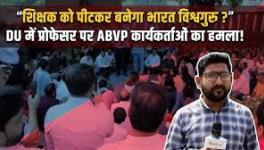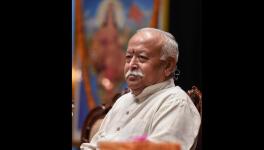Kerala: Onam as a Growing Field of Contestation

Image Courtesy: Wikimedia Commons
‘Onam is a festival celebrated in Kerala.’ Any description beyond this sentence regarding the myth of Onam, the history of Onam, and the particular customs associated with Onam is highly disputed and without concrete evidence. Kerala’s first Chief Minister and communist leader EMS Namboodiripad likened the regime of Maveli to primitive communism and Maveli’s overthrow by Vamanan as the symbolic imagination of the transformation into a new mode of production.
Anti-caste social activist Jyotirao Phule counter-posed Hindu figures, such as Ram and Krishna King Maveli. Phule used figures such as Bali Raja who embodied ideas of equality as a weapon against the casteist forces.
The Right-wing forces, on the other hand, celebrate the other end of the myth, the victory of Vamana (an incarnation of Vishnu, a Hindu god) over the asura king Maveli. The narrative gained political currency when then Bharatiya Janata Party (BJP) president and now Home Minister Amit Shah wished Keralites a ‘Happy Vamana Jayanti’ instead of Onam. This article aims to highlight the ‘popular’ festival of Onam as a field of contestation.
THE HISTORY(S) OF ONAM
Whilst there is not an objective historical origin story to Onam, as a student of popular culture, what tempts one’s curiosity is “What myths were popularised, when, and by whom?” In the course of our examination, we shall be probing into not one but several myths in association with the festival of Onam and how each of them within themselves showcases the ‘contradictions’ in popular culture.
a) The Maveli Onam and the Vamana Jayanti
The most widely accepted account for the celebration of Onam is the return of King Mahabali. The rule of King Mahabali was hailed as egalitarian. The successful reign of Maveli provoked the jealousy of the gods. To cause the downfall of Maveli, the gods sought the help of the deity Vishnu. Vishnu appeared in his fifth incarnation as a diminutive Brahmin called Vamana and requested Maveli to grant him three feet of land. As the generous king Maveli consented, the Vamana assumed a colossal form and covered the whole of the earth in one step, the sky in the second, and raised his foot for the last pace of land. With no more space left and his word to defend, Maveli submitted his head. Vamana stepped on Maveli’s head and pushed him down to the netherworld. Vamana permitted Maveli a yearly visit to meet his people and his kingdom. This once-a-year visit of Maveli is commemorated as the festival of Onam.
The celebration of Onam as Vamana Jayanti and the substitution of the nostalgia of the just asura king Maveli with the fifth incarnation Vamana of deity Vishnu is a forceful counter-narrative. The posing of such a counter-narrative should be read both as the imposition of not just Hindu hegemony in the relatively secular soil of Kerala, but also within the Hindu fold the foregrounding of the upper-caste reading of the popular festival where the devas (gods) triumph over an asura (anti-god) king through the hands of a Brahmin.
The myth of Vamana and Mahabali is popular in several Indian cultures because of mentions in the Bhagavatha Purana and Vishnu Purana, however, it is only in the context of Kerala that the Vamana becomes the villain and Mahabali the hero.
The Rashtriya Swayamsevak Sangh’s (RSS) efforts to portray Vamana as the saviour who liberated Kerala from imperialistic rule and resurrect the now democratic and secular celebration of Onam back in the saddle of Hinduism, should be understood in the larger framework of communalisation.
b) Subaltern Onam?
In his book, Gulamgiri, Phule strongly attacks the characterisation of the Vedic Aryan period as the ‘golden age’ of the sub-continent. He used the concept of avatars and used it instead as a metaphor for the attack of the Aryans and the enslaving of the masses. And the greatest of all heroes, according to Phule, was Bali Raja or Bali the King. According to Phule, the just and benevolent asura king was punished simply for daring to be dharmic even though he was an asura or demon. Thus, the celebration of Mahabali is seen by many Dalit-Bahujans as the non-aryan resistance to the domination of the Aryans, symbolic of the superiority of Brahminism.
Beyond the invocation of Mahabali as a Dalit-Bahujan, Adi-Dravida, or asura counter to the Hindu, Brahminical hegemonic discourses, we can also attempt to read the festival of Onam as a subaltern critique of Vedic-Hindu festivals by the immense participation of the Dalit-Bahujan community in the celebration of Onam.
In Northern Kerala, the Adi-Vedan Theyyam (ritualistic folk dance) is performed by the Malaya caste (Scheduled Caste) in the month of Karkidakkam (the month before Chingam in which Onam is celebrated. After the performance, the Adi-Vedan Theyyam performers are presented with Dakshina (traditional offering made to a Brahmin) by the audience.
Onapottan is another folk illustration from Northern Kerala performed on the ninth and tenth days of Onam. The performance of Onapottan is the traditional right of the Malaya community (Scheduled Caste) in Kerala. The Onapottan practitioners believe in the same myth of Mahabali and Vamana, and perform as representatives of Mahabali.
Pulikkali is the tiger dance performed in Central Kerala, especially in Thrissur. Pulikkali is not a trained dance performance. Instead, the performers imitate their bodily movements to that of a tiger to the beat of Asurathalam (demonic rhythm). The history of Pulikkali takes us down to two ends. The first is the initiative by Maharaja Rama Varma Shakthan Thampuran and the other is a Muslim origin where Pulikkali is performed to commemorate the martyrdom of Ali who held the strength of a tiger, the son-in-law of Prophet Mohammed. Pulikkali is a true example of people’s art as anyone can become a Puli and perform Pulikalli regardless of caste, class, and more recently gender.
Even while we can read the above-mentioned references about and experiences of Onam as resistance against the puranic and Vedic depictions of Mahabali, the ‘double movement’ of resentment and containment can be investigated even within this subaltern perspective.
In India, festivals are bound to agriculture and food in general gains immense importance. The first reference to Onam is found in the poem ‘Madurai-Kanchi’ written by Mangudi Maruthanar in the last decade of the 4th Century B.C. Here Onam is mentioned as a harvest festival celebrated along with a sumptuous feast.
In Kerala, new saplings are sown on the tenth day of Medam. This is followed by the harvest of grains and long-term crops during Chingam. Chingam, the month of Onam, is thus a harvest month that arrives after the rainy season of Karkidakam. Thus Karkidakam is seen as the month of paucity and Chingam as the month of prosperity.
In this context and keeping in mind the feudal history of Kerala, the rightful question of who had the resources to celebrate Onam, comes to the foreground. Was it the Savarna feudal janmis who celebrated Onam? If a Dalit person had to celebrate Onam, he had to either be a good labourer of the feudal lords or be a self-sufficient farmer himself/herself.
The tradition of Onakazcha (submission of agricultural goods to the landlord by the tenant) showcases the residual hierarchy in the celebration of Onam. This is the framework from which a subaltern critique of Onam is formulated. Even today, the prosperity and festivities surrounding Onam are used as a symbolic backdrop to highlight the stark differences in the standards of living among the Adivasis of Kerala on the one hand and the general masses on the other. The example of ‘refugee huts’ being erected on August 30, 2001, in front of the Chief Minister’s residence and the offices of the State Secretariat in Kerala’s capital of Thiruvananthapuram is apt here.
c) Statist Onam or Market Onam?
The "national popular" is a concept Marxist thinker Antonio Gramsci used to describe the process by which a ruling class establishes its hegemony by presenting its values and interests as the values and interests of the entire nation. Gramsci argued that the ruling class achieves the ‘national popular’ by gaining cultural leadership, which involves influencing and shaping the intellectual and cultural life of society.
It was as late as the 19th century when religious festivals came out from the private realms of households to public spaces. Such programmed efforts can also be traced in the case of Onam. In 1961, the Congress government declared Onam as the national festival of Kerala. In Kerala, with strong communist traditions and subsequent communist governments ruling the state, Mahabali was projected as a symbol of social justice.
From the framework of ‘national popular’, the State celebration of Onam can be looked at as an effort to create a regional and linguistic identity within the Malayali community. When Onam becomes the state festival of Kerala, in a sense, it becomes a marker of Malayali identity. In such a conceptualisation, the cultural signifier of Onam can also shape the collective imagination of the people positively, as was exemplified in the modest celebrations following the 2018 floods in Kerala and the distribution of Onam kits during the coronavirus pandemic. In such instances, Onam is used by the State as a ‘bringing back of the golden age’. Government employees are provided with incentives, such as bonuses. This trend was also taken up by the private companies. This extra income is then spent by the people in the markets. This consumption is also aided by traditional practices, such as Onakodi (new garments bought during Onam). In 1971 Neethi/Maveli stores were opened by the State to provide people with necessary items at discounted rates.
Thus, we can see government efforts in bringing people closer to the Onam market. The Onam season witnesses a rise in sales of jewellery, home appliances, furniture, and motor-vehicles. In this cycle of money transfer, the government receives the highest income to its treasury. After the Onam season, they invest it back in the form of increments and advance bonus payments.
CONCLUSION
Socio-cultural entities are essentially in the process of transformation and are most definitely multi-faceted. The myth surrounding Onam is multi-dimensional. As argued by Right-wing forces, Onam cannot be confined within what was written or not about it in the Vedas or Puranas. No festival, celebration, or cultural practice can be said to have originated from a singular source and practiced corresponding to its earliest version. Such an understanding is entirely anti-historic in its portrayal of culture as static and set in time.
Within the regional confines of Kerala, we can discern multiple contrasting interpretations of Onam. Considering all this, that Onam is a festival is a myth that has come up at different junctures of history, in diverse material contexts, and has intertwined unrecognisably as the Onam we celebrate today.
Onam is a myth that has developed out of a complex exchange of cultures over an extensive period. Today, the relevance of Onam lies not in the Vedic, Sangam age or mass celebratory origins of the festival, but in its commercial value. Thus, Onam as a festival has been changing throughout history in the Sangam period, Aryan invasion, feudal Kerala, globalisation, and industrialisation. This myth will keep transforming and taking up new meanings and understandings. “Myth can’t be translated as they did in their ancient soil. We can only find our own meaning in our own time.” (Margaret Atwood)
The writer has recently completed her Masters in Sociology from Jawaharlal Nehru University, Delhi. The views are personal.
Get the latest reports & analysis with people's perspective on Protests, movements & deep analytical videos, discussions of the current affairs in your Telegram app. Subscribe to NewsClick's Telegram channel & get Real-Time updates on stories, as they get published on our website.
























